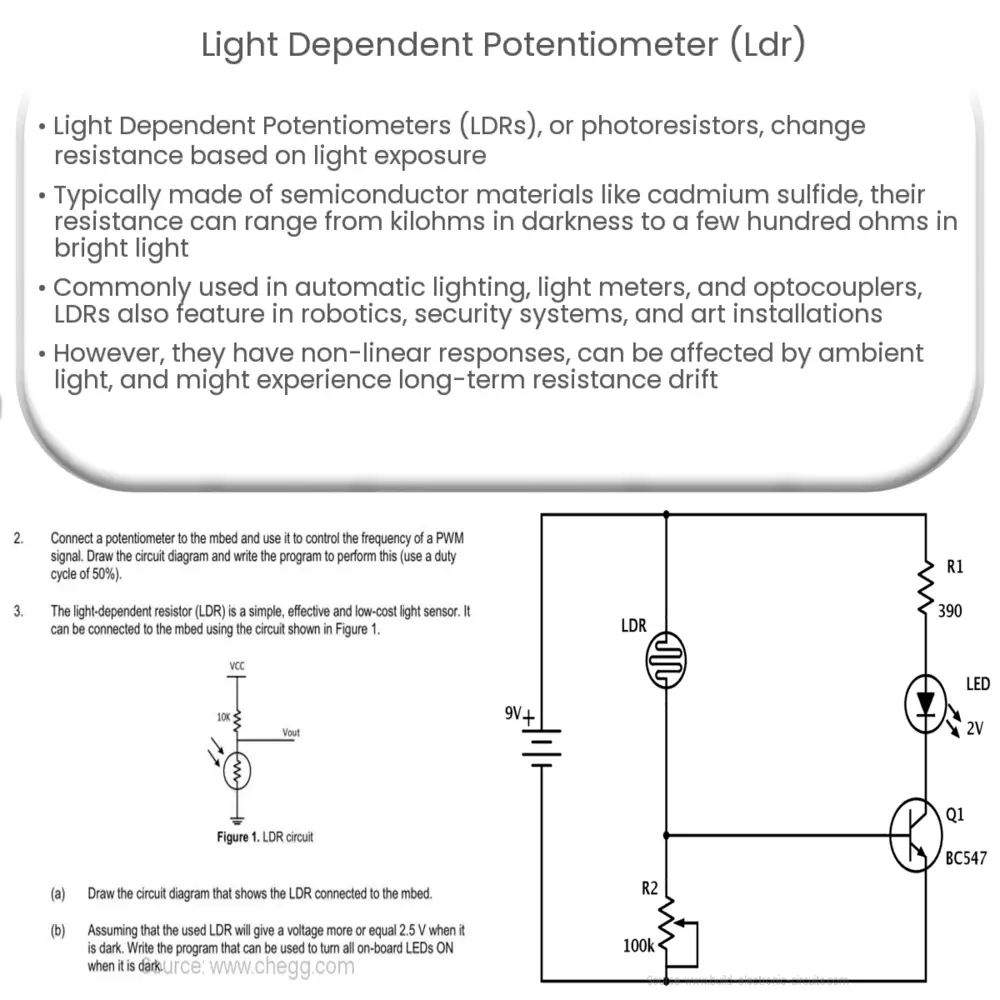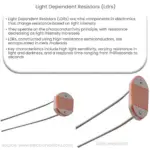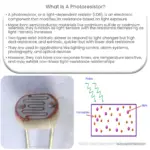A Light Dependent Potentiometer (LDR) is a photoresistor that alters its resistance based on light exposure, used in various applications like automation, security, and art.

Light Dependent Potentiometer (LDR): An Overview of Functionality and Applications
Introduction
Light Dependent Potentiometers (LDRs), also known as photoresistors or photocells, are electronic components that exhibit a change in resistance based on the amount of light they are exposed to. These devices are widely used in a variety of applications, ranging from simple light-sensing circuits to complex systems in robotics, security, and automation. In this article, we will delve into the functionality, characteristics, and common applications of LDRs.
Functionality and Characteristics
LDRs are made of semiconductor materials, typically cadmium sulfide (CdS) or cadmium selenide (CdSe). These materials exhibit photoconductivity, a phenomenon in which their electrical resistance decreases as the intensity of light increases. When light photons interact with the semiconductor material, they generate electron-hole pairs, which in turn increase the conductivity of the material. The resistance of an LDR can vary over several orders of magnitude, from several kilohms in darkness to a few hundred ohms in bright light.
Some key characteristics of LDRs include:
- Response time: LDRs typically have a slow response time, ranging from a few milliseconds to a few seconds. This makes them suitable for applications that do not require rapid light level changes.
- Spectral response: The spectral response of an LDR depends on the material it is made of, and it can be tailored to be sensitive to specific wavelengths of light. For instance, some LDRs are more sensitive to infrared light, while others respond better to visible light.
- Temperature dependence: The resistance of an LDR is also influenced by temperature, with its sensitivity generally decreasing as the temperature increases. This characteristic should be taken into account when designing circuits with LDRs, especially in environments with fluctuating temperatures.
Common Applications
LDRs have found a wide array of applications in various fields due to their simplicity, low cost, and ease of integration into electronic circuits. Some common applications include:
- Automatic lighting systems: LDRs are often used in automatic lighting systems, such as streetlights and outdoor security lights, to turn them on when the ambient light falls below a certain threshold and turn them off when the light level increases.
- Light intensity meters: By measuring the resistance of an LDR and converting it to a corresponding light intensity value, LDRs can be used in light meters for photography or other applications requiring the measurement of ambient light levels.
- Optocouplers: LDRs can be combined with light-emitting diodes (LEDs) to create optocouplers, which are used to isolate electrical signals between different parts of a circuit while allowing for signal transfer through light.
Proximity Sensors
LDRs can also be used as proximity sensors in robotics and automation systems. By emitting a beam of light and monitoring the reflected light with an LDR, the presence of an object within a certain range can be detected. This is particularly useful in applications where physical contact with an object is undesirable or impractical.
Security Systems
Another popular application of LDRs is in security systems, where they can be employed to detect changes in light levels caused by the presence of an intruder. For example, an LDR can be placed in a window or doorway to monitor the ambient light level. If an intruder enters and blocks the light source, the LDR’s resistance will change, triggering an alarm or notification system.
Art and Design
Due to their sensitivity to light, LDRs can be used in interactive art installations and design projects. By integrating LDRs into artworks or products, designers can create dynamic experiences that respond to the presence of light or shadow. This can be particularly effective in public spaces, where people can interact with the installation by casting shadows or directing light sources onto the LDRs.
Limitations and Considerations
While LDRs offer many advantages, there are some limitations and considerations that should be taken into account when using them in projects:
- Non-linear response: The relationship between the resistance of an LDR and light intensity is non-linear, which can make precise measurements challenging. Additional circuitry or calibration methods may be required to obtain accurate results.
- Ambient light interference: Since LDRs are sensitive to all light sources, ambient light can sometimes interfere with their operation. This can be mitigated by using filters, shielding, or directional sensing techniques to minimize the impact of unwanted light sources.
- Long-term stability: The resistance of an LDR can drift over time due to aging, temperature, and environmental factors. Regular calibration or replacement may be necessary to maintain accurate performance.
Conclusion
Light Dependent Potentiometers (LDRs) are versatile and cost-effective electronic components that enable the measurement and control of light levels in a variety of applications. Despite their limitations, LDRs continue to be widely used in industries such as automation, security, and art due to their ease of integration and customization. By understanding the functionality, characteristics, and applications of LDRs, engineers and designers can effectively harness their potential to create innovative solutions that respond to and interact with the surrounding environment.



.png)
